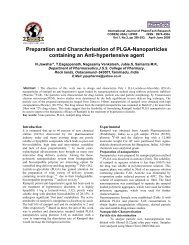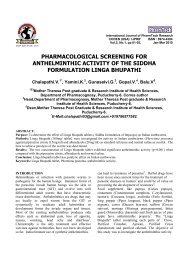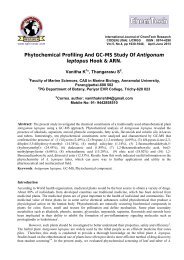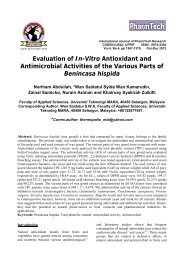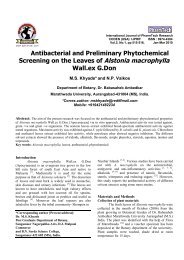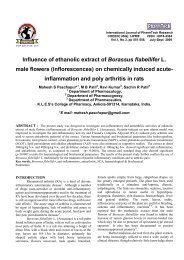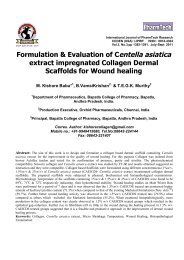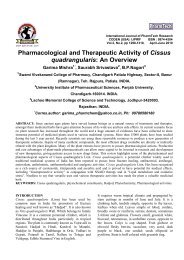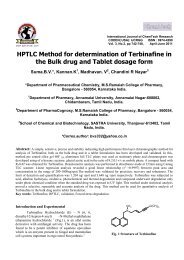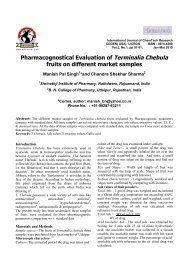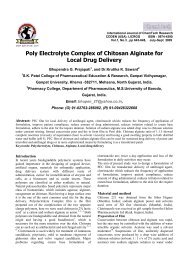Synthesis and Characterisation of Nano crystalline Cerium Nickelate ...
Synthesis and Characterisation of Nano crystalline Cerium Nickelate ...
Synthesis and Characterisation of Nano crystalline Cerium Nickelate ...
You also want an ePaper? Increase the reach of your titles
YUMPU automatically turns print PDFs into web optimized ePapers that Google loves.
S.Ignatius Arockiam et al /Int.J. ChemTech Res.2012,4(2) 799<br />
organic chemical vapor deposition (MOCVD),<br />
molecular beam epitaxial, <strong>and</strong> plasma synthesis<br />
[18,19]. Molten salt synthesis is one <strong>of</strong> the most<br />
versatile techniques to prepare highly ordered complex<br />
oxide materials. The molten salts are used as the<br />
reaction medium for the reactants dissolution <strong>and</strong><br />
product precipitation. Studies have shown that the<br />
products obtained from molten salts are affected by the<br />
synthesis conditions, such as the type <strong>of</strong> salt used, the<br />
annealing temperature, the temperature ramp rate, the<br />
precursor composition, <strong>and</strong> the solubility <strong>of</strong> the<br />
reactive constituents in the molten salt etc, [20-22 ].<br />
The molten salts rendered homogeneous<br />
distribution <strong>and</strong> high intimacy <strong>of</strong> the reactive<br />
components at the atomic scale in the initial mixture <strong>of</strong><br />
precursor salts. Hence, the diffusion distance <strong>and</strong> the<br />
rate <strong>of</strong> the reactive species in molten melts are<br />
modified <strong>and</strong> an efficient material transport is enabled<br />
to meet the minimal kinetic requirement for the<br />
reaction [23-25].<br />
Generally the starting materials for molten salt<br />
synthesis are inorganic compounds such as sulfates,<br />
chlorides <strong>and</strong> oxides, which are blended with the alkali<br />
metal nitrates, chlorides, carbonates, hydroxides as a<br />
powder mixture before heating to the reaction<br />
temperature. Many complex oxide materials have been<br />
synthesized by molten salt technique [26-29].<br />
Even though, many s<strong>of</strong>t chemical routes have been<br />
attempted, only few studies have been made on the<br />
CeO2<br />
NaCl/KCl Flux<br />
synthesis <strong>of</strong> CeNiO3 compounds using molten flux<br />
method. Hence, an attempt has been made on the<br />
preparation <strong>of</strong> CeNiO3 by this method.<br />
Experimental work<br />
Reagent-grade chemicals like cerium oxide<br />
(CeO2), nickel oxide (NiO) were used as the starting<br />
materials. They were obtained from Merck India Ltd,<br />
Bombay. Appropriate amount <strong>of</strong> chloride salts such as<br />
sodium chloride (NaCl) <strong>and</strong> potassium chloride (KCl)<br />
were used as the flux. They were thoroughly ground<br />
using a mortar <strong>and</strong> pestle <strong>and</strong> were placed in a high<br />
density alumina crucible. The mixture was then heated<br />
in an electrical resistance furnace at 900 0 C for 12 hrs.<br />
The heating rate was 200 °C per hour for all the<br />
experiments.The resulting reaction mixture was cooled<br />
to ambient temperature <strong>and</strong> it was washed with hot<br />
water for several times. The unreacted cerium, nickel,<br />
alkaline salts were removed by treating with these<br />
solvents. The residual powders were dried in a vacuum<br />
oven at 50 °C for 1 hour <strong>and</strong> cooled to room<br />
temperature. The method <strong>of</strong> synthesis is presented in<br />
the form <strong>of</strong> a flow chart <strong>and</strong> shown in fig.1. Finally<br />
free flowing fine powders were obtained <strong>and</strong> they were<br />
characterized for their physicochemical properties.<br />
Mixed <strong>and</strong> placed in Alumina crucible<br />
Thermal treatment at 900 0 C<br />
Washing with hot water<br />
Dyring in hot air oven<br />
Fine <strong>crystalline</strong> CeNiO3<br />
Fig-1: Flow chart for the preparation <strong>of</strong> CeNiO3 compound.<br />
NiO



